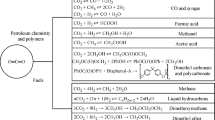Abstract
The physicochemical characteristics of the carbon material produced by methane conversion in UHF discharge plasma are determined. The material is characterized by high carbon content (99.4 wt %); the calorific value is 32.7 MJ/kg; and the packing density is 25.5 kg/m3. According to X-ray phase analysis, the crystalline content of the sample is ~43%. Morphologically, it consists of spherical agglomerates (no larger than 20 μm) composed of numerous nanoparticles. The mean particle size is 80–120 nm; the specific surface is 51.2 m2/g; and the mean pore volume is 0.25 cm3/g.




Similar content being viewed by others
REFERENCES
Key World Energy Statistics 2020, Vienna: Int. Energy Agency, 2020, vol. 33.
State and Trends of Carbon Pricing 2021, Washington, DC: World Bank, 2021.
Timmerberg, S., Kaltschmitt, M., and Finkbeiner, M., Hydrogen and hydrogen-derived fuels through methane decomposition of natural gas–GHG emissions and costs, Energy Convers. Manage.: X, 2020, vol. 7, p. 100043.
Keipi, T., Hankalin, V., Nummelin, J., and Raiko, R., Techno-economic analysis of four concepts for thermal decomposition of methane: reduction of CO2 emissions in natural gas combustion, Energy Convers. Manage., 2016, vol. 110, pp. 1–12.
Keipi, T., Tolvanen, H., and Konttinen, J., Economic analysis of hydrogen production by methane thermal decomposition: comparison to competing technologies, Energy Convers. Manage., 2018, vol. 159, pp. 264–273.
Jašek, O., Toman, J., Šnírer, M., et al., Microwave plasma-based high temperature dehydrogenation of hydrocarbons and alcohols as a single route to highly efficient gas phase synthesis of freestanding graphene, Nanotechnology, 2021, vol. 32, no. 50, p. 505608.
Mašláni, A., Hrabovský, M., Křenek, P., et al., Pyrolysis of methane via thermal steam plasma for the production of hydrogen and carbon black, Int. J. Hydrogen Energy, 2021, vol. 46, no. 2, pp. 1605–1614.
Stankovich, S., Dikin, D.A., Dommett, G.H.B., et al., Graphene-based composite materials, Nature, 2006, vol. 442, no. 7100, pp. 282–286.
Liu, X. and Dai, L., Carbon-based metal-free catalysts, Nat. Rev. Mater., 2016, vol. 1, no. 11, p. 16064.
Wang, X., Li, Z., Chen, Z., et al., Structural modification of carbon black for improving the dielectric performance of epoxy based composites, Adv. Ind. Eng. Polym. Res., 2018, vol. 1, no. 1, pp. 111–117.
Chigodaeva, D.V., Shiyan, V.P., and Tsybenova, N.A., Plasma-chemical plant for the conversion of natural gas into carbon and hydrogen, Vektory Blagopoluchiya Ekon. Sotsium, 2012, vol. 4, no. 5, pp. 60–65.
Ibrahim, H., Sazali, N., Salleh, W.N.W., et al., Outlook on the carbon-based materials for heavy metal removal, Biointerface Res. Appl. Chem., 2022, vol. 12, no. 4, pp. 5303–5323.
Matyukhin, V.I., Stukov, M.I., Babanin, V.B., et al., Improving the shaft smelting of minerals by changing the activity of coke, Coke Chem., 2014, vol. 57, no. 3, pp. 106–111.
Larionov, K.B., Yankovsky, S.A., Gubin, V.E., et al., Production of briquetted semicoke from wood waste by multistep low-temperature pyrolysis, Coke Chem., 2020, vol. 63, no. 12, pp. 592–598.
Gong, X., Guo, Z., and Wang, Z., Reactivity of pulverized coals during combustion catalyzed by CeO2 and Fe2O3, Combust. Flame, 2010, vol. 157, no. 2, pp. 351–356.
Wu, G., Asai, S., Sumita, M., and Yui, H., Entropy penalty-induced self-assembly in carbon black or carbon fiber filled polymer blends, Macromolecules, 2002, vol. 35, no. 3, pp. 945–951.
Wibawa, P.J., Nur, M., Asy’ari, M., and Nur, H., SEM, XRD and FTIR analyses of both ultrasonic and heat generated activated carbon black microstructures, Heliyon, 2020, vol. 6, no. 3, p. e03546.
Funding
Financial support was provided under supplementary contract 075-03-2021-138/3 for the funding of state projects and services (project number FZES-2021-0008).
Author information
Authors and Affiliations
Corresponding authors
Additional information
Translated by B. Gilbert
About this article
Cite this article
Larionov, K.B., Jankovsky, S.A., Pak, A.Y. et al. Characteristics of the Carbon Byproduct from Methane Conversion in UHF Discharge Plasma. Coke Chem. 65, 107–111 (2022). https://doi.org/10.3103/S1068364X22030036
Received:
Revised:
Accepted:
Published:
Issue Date:
DOI: https://doi.org/10.3103/S1068364X22030036




